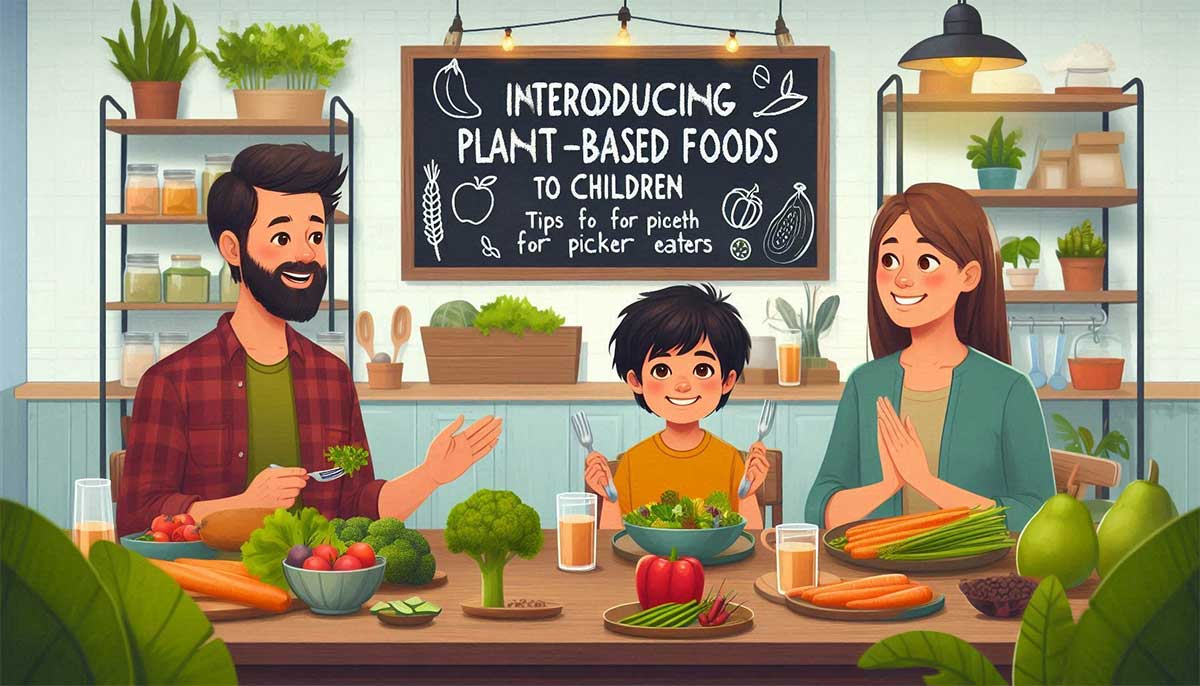As a parent, you want the best for your child, and that includes a healthy and balanced diet. But let’s face it, getting kids to eat their veggies can be a daily struggle. If you’re considering introducing plant-based foods to your little ones, you’re on the right track. A well-planned plant-based diet can provide numerous health benefits for kids, from boosting energy levels to supporting healthy growth and development. In this post, we’ll explore effective strategies for introducing plant-based foods to even the pickiest of eaters, and provide you with practical tips and examples to make mealtime a breeze.
Key Takeaways:
- Make it Fun and Appealing: Presenting plant-based foods in a visually appealing way can make them more attractive to picky eaters. Try using different shapes, colors, and garnishes to make mealtime engaging and exciting.
- Involve Children in the Cooking Process: Encourage kids to participate in meal planning and preparation. This can help them feel more invested in trying new foods and develop important skills like cooking and nutrition.
- Create a Positive Eating Environment: Foster a relaxed and supportive atmosphere during meals by avoiding pressure or criticism. Instead, focus on modeling healthy eating habits and having open conversations about food preferences and choices.

Making Plant-Based Foods Fun and Appealing
For kids, mealtime is not just about sustenance, but also about experience and enjoyment. When introducing plant-based foods to your little ones, it’s imperative to make them fun and appealing. This can be achieved by getting creative with presentation, involving them in the cooking process, and creating a positive eating environment.
By making plant-based foods visually appealing, you can spark your child’s curiosity and encourage them to try new dishes. Moreover, when kids are involved in the cooking process, they’re more likely to take ownership of their meal choices and develop healthy eating habits. In this section, we’ll explore some practical tips and ideas to make plant-based foods fun and appealing for your picky eaters.
Creative Presentation Ideas
On a typical day, a plate of veggies might not be the most exciting sight for your child. However, with a little creativity, you can turn mealtime into a fun and engaging experience. Try arranging vegetables into fun shapes or creating a fruit kebab with their favorite fruits. You can also use cookie cutters to cut out fun shapes from whole grain bread or crackers. These small touches can make a big difference in making plant-based foods appealing to your child.
Another idea is to create a “food face” on their plate using sauces, hummus, or avocado. This can add a playful touch to mealtime and make your child more excited about trying new foods. You can also try serving meals in fun and colorful containers or plates with their favorite characters. These small details can make mealtime more enjoyable and engaging for your child.
Make-Your-Own Plant-Based Meals
The key to getting your child excited about plant-based foods is to involve them in the cooking process. By letting them create their own meals, you’re giving them a sense of control and ownership over their food choices. This can be as simple as letting them assemble their own salads or wraps with their favorite ingredients.
Appealing to your child’s creativity and independence can be a powerful way to encourage healthy eating habits. When they’re involved in the cooking process, they’re more likely to try new foods and develop a sense of pride in their creations. In the next section, we’ll explore more ideas for making plant-based foods fun and appealing, including tips for creating a positive eating environment.
Involving Children in the Cooking Process
Little hands can be a big help in the kitchen, and involving your child in the cooking process can be a great way to encourage them to try new plant-based foods. Not only will they be more invested in the meal, but they’ll also learn valuable skills and have fun doing it. By giving your child a sense of ownership and control over the cooking process, you can help them feel more confident and excited about trying new foods.
Plus, involving your child in cooking can be a great bonding experience for the whole family. You can chat about your day, share stories, and create memories while you chop, stir, and season together. And, who knows, you might just inspire a future chef or food enthusiast!
Simple Recipes for Kids to Help With
The best recipes for kids to help with are often the simplest ones. Look for recipes that require minimal ingredients and steps, and that allow your child to get their hands dirty. Some great options might include making a fruit salad, assembling a veggie wrap, or even just washing and chopping fresh veggies for a stir-fry. The key is to keep it fun and engaging, and to let your child take the lead whenever possible.
For example, you could try making a simple vegan quesadilla together. Your child can help with tasks like shredding the cheese (made from nuts or soy, of course!), spreading the beans, and assembling the tortilla. They’ll love the feeling of creating something delicious and getting to enjoy the fruits of their labor afterwards.
Benefits of Cooking Together
With your child by your side in the kitchen, you can reap a range of benefits that go far beyond just getting them to eat their veggies. For one, cooking together can help your child develop important skills like measurement, following instructions, and fine motor control. It can also help them learn about different cultures and cuisines, and develop an appreciation for the effort that goes into preparing a meal.
Additionally, cooking together can be a great way to encourage healthy eating habits and a positive relationship with food. By involving your child in the cooking process, you can help them understand where their food comes from, and develop a sense of responsibility for their own health and well-being.
It’s also worth noting that cooking together can be a great way to reduce pickiness and increase willingness to try new foods. When your child has a hand in preparing a meal, they’re more likely to feel invested in the outcome and proud of what they’ve created. This can make them more open to trying new ingredients and flavors, and more willing to take risks in the kitchen.
Creating a Positive Eating Environment
Keep in mind that mealtime is not just about feeding your child, but also about creating a positive and enjoyable experience. A warm and welcoming atmosphere can go a long way in encouraging your child to try new foods, including plant-based options. By setting the tone for a relaxed and fun mealtime, you can help your child feel more open to exploring new flavors and textures.
A positive eating environment is crucial for helping your child develop healthy relationships with food. When mealtimes are stressful or rushed, it can lead to pickiness and resistance to trying new foods. On the other hand, a calm and supportive atmosphere can help your child feel more confident and curious about new foods.
Setting the Table for Success
For a successful mealtime experience, start by setting the table in a way that’s inviting and engaging. Use colorful plates, utensils, and napkins to add a pop of color to the table. You can also add some fresh flowers or a small centerpiece to create a warm and welcoming ambiance. By making mealtime feel special, you can help your child look forward to trying new foods and enjoying quality time with the family.
Additionally, consider turning off the TV and putting away electronic devices during mealtime. This can help create a sense of togetherness and encourage conversation and interaction. By making mealtime a device-free zone, you can help your child focus on the food and the company, rather than distractions.
Reducing Mealtime Stress
On average, children are exposed to thousands of advertisements for unhealthy foods every year, which can make them more resistant to trying new, healthier options. To reduce mealtime stress, try to limit exposure to these ads and instead focus on promoting positive messages about healthy eating.
This can be as simple as having a conversation with your child about the benefits of plant-based eating or reading a book together about healthy food choices. By framing healthy eating in a positive and empowering way, you can help your child feel more excited and motivated to try new foods.
This approach can also help to shift the focus away from what your child won’t eat and towards what they will eat. By celebrating small victories and acknowledging progress, you can help build your child’s confidence and encourage them to continue trying new foods.
Addressing Common Concerns
To ease your mind and ensure a smooth transition to a plant-based diet for your little ones, let’s tackle some common concerns you may have.
“My Child Won’t Eat Vegetables!”
On the surface, it may seem like a daunting task to get your child to eat vegetables, but with patience and creativity, it’s definitely achievable. One approach is to start small – try incorporating finely chopped veggies into foods they already enjoy, like pasta sauce or muffins. You can also make mealtime more engaging by creating a “veggie face” on their plate using sliced veggies or serving them with dips they love.
Another strategy is to involve your child in the cooking process. Let them help with meal planning and grocery shopping, and encourage them to pick out a new vegetable to try each week. This sense of ownership and control can make them more excited to try new foods.
“Is a Plant-Based Diet Safe for My Child?”
Childhood is a critical period for growth and development, and you may worry that a plant-based diet won’t provide enough imperative nutrients. Rest assured, a well-planned plant-based diet can be incredibly nutritious and beneficial for kids.
Concerns about protein, iron, and calcium intake are common, but with a little planning, you can ensure your child is getting all the necessary nutrients. For example, legumes, beans, and lentils are rich in protein, while dark leafy greens like spinach and kale are packed with iron. Calcium-rich plant-based sources include fortified plant milk, tofu, and dark leafy greens like broccoli and kale.
Practical Tips for Picky Eaters
Unlike what you might think, introducing plant-based foods to picky eaters doesn’t have to be a daunting task. With a little creativity and patience, you can help your child develop a taste for nutritious and delicious plant-based options. Here are some practical tips to get you started:
- Lead by example: Children often mimic their parents’ behavior, so make sure you’re eating and enjoying plant-based foods in front of them.
- Make it fun: Use fun shapes and colors to make mealtime engaging and interactive.
- Involve them in the process: Let your child help with meal planning and grocery shopping to get them excited about trying new foods.
- Be consistent: Offer plant-based options regularly, even if they don’t take to them right away.
Any small step towards a plant-based diet is a step in the right direction!
Start Small and Be Patient
Eager eaters often dive headfirst into new foods, but picky eaters need a more gentle approach. Start by introducing small amounts of plant-based foods into their diet, such as a sprinkle of spinach in their favorite smoothie or a few slices of avocado on their sandwich. Be patient and don’t force them to eat something they’re not comfortable with – this can create negative associations with the food.
Bear in mind, the goal is to make progress, not to revolutionize their diet overnight. By starting small and being patient, you can help your child develop a taste for plant-based foods over time. And who knows, they might just surprise you by asking for seconds!
Sneak It In (But Not Too Much!)
Much like adding a pinch of magic to a recipe, sneaking plant-based ingredients into familiar dishes can be a great way to get your picky eater on board. Try adding finely chopped veggies like bell peppers or zucchini to their favorite pasta sauce or meatballs.
Small amounts of hidden veggies can add up to make a big difference in their nutrient intake. Just be careful not to overdo it – if your child discovers they’ve been duped, they might become resistant to trying new foods altogether. A balanced approach is key!
For example, you could try making a vegan version of their favorite mac and cheese by adding steamed broccoli or carrots to the sauce. The key is to find a balance between hiding the veggies and still maintaining the flavor and texture they love. With a little creativity, you can create healthy plant-based recipes for kids that they’ll actually enjoy!
Healthy Plant-Based Recipes for Kids
Your journey to introducing plant-based foods to your kids wouldn’t be complete without some delicious and easy-to-make recipes that they’ll love. In this section, we’ll explore some kid-friendly vegan meals and snack time favorites that are perfect for picky eaters.
Bear in mind, the key to getting your kids to eat plant-based foods is to make it fun and engaging. Involve them in the cooking process, let them help with meal planning, and be patient with their preferences. With time and consistency, they’ll develop a taste for these healthy and nutritious options.
Kid-Friendly Vegan Meals
To make mealtime a breeze, try these vegan meals that are sure to please even the pickiest of eaters. From veggie-packed pasta sauces to flavorful stir-fries, these recipes are designed to be fun and interactive.
Some of our favorite kid-friendly vegan meals include vegan mac and cheese, lentil soup, and veggie quesadillas. You can also try making your own vegan pizza with a variety of toppings, or whip up a batch of vegan chicken nuggets made from tofu or tempeh.
Snack Time Favorites
Kids love snacks, and with these healthy plant-based options, you can feel good about what they’re putting in their bodies. From fresh fruit kebabs to homemade trail mix, these snacks are easy to make and fun to eat.
Recipes like vegan banana bread, energy balls, and chocolate-dipped fruit are perfect for snack time. You can also try making your own vegan granola bars or crackers for a quick and easy snack on-the-go.
Recipes like these are not only delicious but also packed with nutrients and vitamins that will keep your kids energized and focused throughout the day. Plus, they’re easy to customize to your child’s tastes and preferences, making snack time a breeze.
Conclusion
From above, it’s clear that introducing plant-based foods to picky eaters requires patience, creativity, and a willingness to make mealtime a positive experience. By making foods fun and appealing, involving your children in the cooking process, and creating a warm and welcoming eating environment, you can set your kids up for a lifetime of healthy eating habits. Keep in mind, it’s not about forcing your children to eat something they don’t want to, but about gently guiding them towards a more balanced and nutritious diet.
As you initiate on this journey, keep in mind that every child is different, and what works for one may not work for another. Be prepared to try new approaches, and don’t be discouraged by setbacks. With time, consistency, and a little bit of creativity, you can help your picky eaters develop a love for plant-based foods that will benefit them for years to come. So, take a deep breath, get cooking, and watch your kids thrive on a healthy, plant-based diet that’s full of flavor, variety, and fun!





